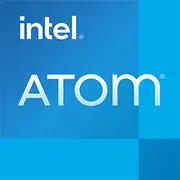Intel Atom N570

Intel Atom N570: A Retrospective on a Budget Processor for Compact Devices
April 2025
Introduction: A Legacy of the Netbook Era
Released in 2011, the Intel Atom N570 became a symbol of the era of ultraportable and affordable laptops—"netbooks." Despite being considered outdated in 2025, this processor is still found in specialized devices (kiosks, terminals) and budget models for emerging markets. In this article, we will explore why the N570 is still mentioned in niche reviews and who it may still benefit.
Architecture and Process: 45 nm and Modest Ambitions
Cores, Threads, and Frequencies
The Atom N570, based on the Bonnell architecture (codename Pineview), is manufactured using a 45 nm process. It is a dual-core processor with support for Hyper-Threading, allowing for 4 logical threads. Its base clock frequency is 1.66 GHz, with no turbo mode available.
Integrated Graphics
The built-in GPU (GMA 3150) was part of the NM10 chipset rather than the processor itself. This limited its performance to supporting only DirectX 9 and resolutions up to 1080p for video. It is unsuitable for gaming or rendering— even simple browser-based 3D content would cause lags.
Cache and Memory
- L2 Cache: 1 MB (shared between the two cores).
- Memory support: DDR3 up to 2 GB (single-channel mode).
Power Consumption and TDP: 9 W as the Foundation of Portability
With a TDP of 8.5–9 W, the N570 was ideal for passively cooled devices. This enabled the creation of thin (by 2010s standards) netbooks without fans, such as the ASUS Eee PC 1015PN.
Thermal Characteristics
- Maximum temperature: 90°C.
- Energy efficiency was achieved through reduced functionality: lack of AVX, limited instruction set.
Performance: Modest Results Even for Its Time
Office Tasks
- Example: Working in LibreOffice or older versions of Microsoft Office (2010). Opening documents took 3-5 seconds, but simultaneously launching a browser with 5+ tabs resulted in noticeable stuttering.
- 2025 Recommendation: The N570 is not suitable for modern web applications (Google Workspace, Zoom)—it lacks the power.
Multimedia
- Playing 720p video (H.264) is possible, but 1080p puts the CPU load up to 80-90%.
- Example: YouTube in Chrome (2023+ versions) with hardware acceleration—frames are dropped even at 480p.
Gaming
- 2000s games: Half-Life 2 on low settings—20-25 FPS.
- Modern indie games (e.g., Stardew Valley) can launch, but frequently drop to 15 FPS.
Use Cases: Who is the N570 Relevant for in 2025?
1. Educational Devices: Budget laptops for schools in Asian and African countries (price of new models—$120-150). Example: Lenovo IdeaPad 100S (2024).
2. Specialized Equipment: Payment terminals, information kiosks.
3. Retro Enthusiasts: Building compact PCs to run old operating systems (Windows XP, Linux Lubuntu).
Battery Life: Myth or Reality Up to 8 Hours?
With a battery capacity of 24–30 Wh (typical for netbooks from 2011–2013), the runtime reached 6–8 hours in PDF reading mode. However, in 2025, new devices with the N570 are equipped with 40 Wh batteries, theoretically providing up to 10 hours.
Power-Saving Technologies:
- Enhanced Intel SpeedStep: Dynamic frequency scaling.
- C-states: Turning off unused cores.
Challenges: Modern operating systems (Windows 11, Ubuntu 24.04) are less optimized for such old processors, reducing battery life by 20-30%.
Comparison with Competitors: Who Dominated the Budget Segment?
1. AMD Fusion C-50 (2011): 2 cores, 1 GHz, Radeon HD 6250. Better graphics but lower CPU performance.
2. Intel Atom Z3735F (Bay Trail, 2014): 4 cores, 1.33–1.83 GHz, 22 nm. 40% more energy-efficient.
3. Apple A5 (2011): Used in iPad 2. Comparable in performance, but for a different platform.
2025 Conclusion: The N570 lags behind even budget Cortex-A75 processors (in $100 smartphones).
Pros and Cons: Why is it Still Being Produced?
Pros:
- Extremely low chip cost (less than $10 for OEMs).
- Compatibility with outdated software.
- Easy integration into devices without active cooling.
Cons:
- Does not support modern instructions (AVX, AES-NI).
- Maximum of 2 GB RAM—a limitation for operating systems after 2018.
- No support for USB 3.0 and Wi-Fi 6.
Recommendations for Choosing a Laptop: What to Look for in 2025?
If you are considering a device with the N570, make sure that:
1. Purpose: Only for text tasks, email, or basic education.
2. RAM: At least 2 GB (better 4 GB if the chipset allows).
3. Storage: SSD (even 64 GB) instead of HDD will speed things up.
4. OS: Linux (Lubuntu, Puppy) or Windows 10 LTSC.
Examples of New Devices:
- Vorke V3 Mini PC (2024): Price—$130, 4 GB RAM, 64 GB eMMC, HDMI.
- Chuwi Gemibook Lite (2025): 11.6" screen, 6 hours of battery life, $149.
Final Conclusion: Who is the N570 a Reasonable Choice For?
The Intel Atom N570 in 2025 is:
- For whom: Users with a budget of up to $150 who need a device for typing, PDF viewing, or children's education.
- Alternatives: Raspberry Pi 5 (4 GB, $60) with a keyboard and monitor—three times more powerful.
- Key Benefit: Price. If you are purchasing the device as "disposable" (e.g., for guest use in a café), the N570 makes sense.
Advice: In 95% of cases, it is better to pay an additional $50–70 and get a laptop with a Celeron N4500 (2023) or Snapdragon 7c—they will support modern applications and last longer.
Conclusion: The Intel Atom N570 is a relic that has survived in niche products. Its time has passed, but under harsh economic conditions, it still finds its fans.
Basic
CPU Specifications
Memory Specifications
GPU Specifications
Benchmarks
Compared to Other CPU
Share in social media
Or Link To Us
<a href="https://cputronic.com/en/cpu/intel-atom-n570" target="_blank">Intel Atom N570</a>